Services on Demand
Journal
Article
Indicators
-
 Cited by SciELO
Cited by SciELO -
 Access statistics
Access statistics
Related links
-
 Cited by Google
Cited by Google -
 Similars in
SciELO
Similars in
SciELO -
 Similars in Google
Similars in Google
Share
DYNA
Print version ISSN 0012-7353On-line version ISSN 2346-2183
Dyna rev.fac.nac.minas vol.77 no.161 Medellín Jan./Mar. 2010
GEOENVIRONMENTAL CHARACTERIZATION OF THE SAN QUINT ÍN MINE TAILINGS, CIUDAD REAL ( SPAIN )
CARACTERIZACIÓN GEOAMBIENTAL DE LA BALSA DE LODOS DE LA MINA DE SAN QUINTÍN (CIUDAD REAL)
DAVID GÓMEZ-ORTIZ
Área de Geología, ESCET, Universidad Rey Juan Carlos, Madrid, david.gomez@urjc.es
TOMÁS MARTÍN-CRESPO
Área de Geología, ESCET, Universidad Rey Juan Carlos, Madrid, tomas.martin@urjc.es
JOSÉ MARÍA ESBRÍ
Dpto. Ingeniería Geológica y Minera, Universidad Castilla-La Mancha, Ciudad Real, JoseMaria.Esbri@uclm.es
Received for review June 17 th, 2009, accepted December 21th, 2009, final version January 7 th, 2009
ABSTRACT: The abandoned San Quintín mining group ( Ciudad Real) was operated by the Sociedad Minero-Metalúrgica de Peñarroya, and 515.300 tons of galena concentrates were obtained between 1888 and 1923. Two geophysical surveys, using electrical resistivity imaging (ERI) and ground-penetrating radar, as well as mineralogical and geochemical techniques have been used in order to obtain a geo-environmental characterization of the mine pond. The ERI has allowed us to determine both the general geometry of the ponds substrate and a maximum thickness of the mine tailings of 12 m. Tailings are medium-to-coarse grained materials mainly composed of quartz, clay minerals, gypsum and feldspars. Neither acid mine drainage nor modification of their internal structure have been detected. The amount of ore minerals in the tailings have been greatly reduced because of their reworking. Joint application of geophysical and geochemical techniques has revealed as very useful for obtaining a complete characterization of abandoned mine deposits, previously to a future reclamation of these hazardous tailings.
KEYWORDS: tailing pond, electrical resistivity tomography, geochemistry, ground-penetrating radar, San Quintín.
RESUMEN: El grupo minero de San Quintín (Ciudad Real), del que la Sociedad Minero-Metalúrgica de Peñarroya extrajo 515.300 toneladas de concentrados de galena entre 1888 y 1923, se encuentra actualmente abandonado. Para la caracterización geoambiental de una balsa de lodos de este grupo minero, se han utilizado dos técnicas geofísicas someras, tomografía eléctrica 2D y georadar, y técnicas mineralógicas y geoquímicas. Se han determinado los límites de la balsa, un espesor máximo de relleno de unos 12 m, y que está constituido por materiales de granulometría arenoso-arcillosa formados principalmente por cuarzo, minerales del grupo de la arcilla, yeso y feldespatos. No se han detectado indicios de drenaje ácido en la balsa ni de modificación de su estructura interna. Los trabajos últimos de relavado han reducido la cantidad de minerales metálicos en los lodos. El uso combinado de técnicas se muestra muy útil en la caracterización de depósitos mineros abandonados, paso previo a los trabajos futuros de restauración ambiental de este tipo de residuos medioambientalmente peligrosos.
PALABRAS CLAVE: balsa de lodos, tomografía eléctrica, geoquímica, georadar, San Quintín.
1. INTRODUCTION
Mine tailings are watery sludges composed of medium-to-fine-grained material, resulting from grinding and mineral processing (e.g., galena, pyrite, chalcopyrite, arsenopyrite). They are piled up as less than 5 cm thick sedimentary levels, differentiated by slight granulometric and/or compositional differences. They entail both an accumulation and a potential subsequent emission source of trace elements (Cu, Fe, Pb, Zn, ) with formation of acid drainage due to oxidation of the sulphides present in the mine tailings, either because they were not sufficiently benefited or due to the existence of a deficient extractive technology by the time they were exploited. Mine ponds are, therefore, an important environmental problem, all the more if they constitute abandoned deposits. Previous similar works have focused on the study of potentially hazardous metals (e.g. [1]).
The selected area, the San Quintín mine tailings, is located to the north of Puertollano, in the Ciudad Real province, Spain (Fig. 1a, b). This sludge pond is crossed by the Don Quixote Route, a tourist set of itineraries that the local government drawn up in 1995 in order to celebrate the IV Centenary of the publishing of El ingenioso hidalgo Don Quijote de La mancha (Fig. 1c). This route, the longest ecotourist way in Europe, has already been declared as Cultural Itinerary by the Council of Europe, and soon it could reach the rank of Humanity Heritage because of its environmental and cultural goodness. These features therefore make the San Quintín mining group a busy tourist itinerary. That is the reason why an environmental characterization of it in order to determine its potential hazard is so necessary.
In this work we have applied mineralogical and geochemical characterization techniques (X-Ray Diffraction and X-Ray Fluorescence) and shallow, non destructive geophysical techniques (Electrical Resistivity Imaging and Ground Penetrating Radar) to get a detailed picture of the mine pond geometry, composition and thickness of its infilling, possible existence of water flows within it and occurrence of acid mine drainage leaks. The study has been carried out in order to characterize the present condition of the pond previously to the hypothetical reclamation.
2. STUDY AREA
The San Quintín mine is located on the city council of Villamayor de Calatrava, to the north of Puertollano, Ciudad Real province, Spain . This mining group is composed by two mining zones separated about 500 m in distance: San Quintín West and San Quintín East, in which the mining pond studied in the present work is located. The ore veins were exploited to more than 700 m in depth and 2500 m in length. The first working data are from 1559, although the intensive exploitation began in 1606. This was perfomed by the Sociedad Minero-Metalúrgica de Peñarroya España (SMMPE) from 1887 to 1934, date of the mining closure. In 1973, a new flotation plant was installed for re-working of about three million tons of mineral from the tailings [2-3]. At the 1980s, a preliminary Environmental Impact Assessment was carried out. In it, the ore was described as mainly composed by intensively exploited galena and sphalerite as essential phases of a complex hydrothermal mineralization including pyrite, marcasite, chalcopyrite, pyrrotine, siderite, bournonite, boulangerite and ankerite as ore minerals, and a gangue composed by quartz, barite and calcite. Thus, important amounts of Cu, Fe, Pb and Zn were expected to be found in the metallurgical tailings. At present, the San Quintín mining group is abandoned, and ruins of the mine structures, together with several mine tailings and ponds are clearly recognised. Tailings resulting from re-working were dumped in both ponds.
3. METHODOLOGY
In order to characterize the mine pond, two non-destructive shallow geophysical techniques have been used: electrical resistivity imaging (ERI) and ground penetrating radar (GPR) (Fig. 1d).
ERI technique allows us to obtain the thickness and depth of the subsurface geological materials from the measurement of resistivity values (e.g. [4-5]). An iterative method of inversion is used in order to convert the apparent resistivity values into true resistivity and depth. ERI is a useful technique both to determine the location of the water table and to locate pollution plumes. Regarding the mine ponds, a strong resistivity contrast exists between the infilling of the pond and the materials constituting the substrate, obtaining good results to define the mine ponds substrate. It has been successfully used in mine ponds located in both Rio Tinto [6-7] and Cartagena-La Unión mine districts [8]. In this work, a Syscal Junior Switch 48 resistivity equipment has been used. The Wenner-Schlumberger array has been chosen due to its good relationship between investigation depth and resolution (e. g. [9]). Four ERI profiles (Fig. 1a), with lengths ranging from 94 to 235 m and electrode spacing from 2 to 5 m respectively, have been carried out. The maximum investigation depth reached has been 25 m. The inversion of apparent resistivity values has been performed with the RES2DINV software.
GPR is a technique based on the propagation of electromagnetic (EM) waves through different materials. An antenna located on the ground surface generates wave pulses that propagate, reflect and/or diffract at the boundaries between different materials. These boundaries represent changes in the dielectrical permittivity values. The two-way-travel times can be converted into depth values by means of the propagation velocity of EM waves. The reflections of the EM waves are due to changes in the electrical properties of materials, variations in their water content or density changes, as well as stratigraphic boundaries and voids. Thus, the success of the GPR technique will be linked to the occurrence of boundaries separating zones with strong contrasts of the dielectrical permittivity values. Both penetration depth and resolution are mainly function of two parameters: the wavelength of the transmitting pulse and the dielectrical constant of the materials. These parameters are highly dependent on the water content of the geological materials (e. g. [10, 4]). GPR is mainly used to locate lithological boundaries or fractures, characterize soils, and determine the depth to the water table. In this work, GSSI SIR-3000 equipment has been used together with a 200 MHz shielded antenna. The horizontal data spacing of the profiles is 0.10 m, and the two-way-travel time window is 160 ns.
Samples from the mine tailings were collected with an Eijkelkamp soil core sampler for undisturbed samples with a known volume and diameter (Fig. 1e). Sampling was sequential with a vertical constant spacing of 25 cm. It was carried out by deepening down from the mine pond surface, casting aside the part corresponding to superficial sealing and avoiding the fall of the perforation walls material. With this procedure, a total of 23 samples were taken in three points at different distance from the dump point: SQ-2 and SQ-3 up to 2m depth and SQ-1 up to only 1m. Geochemical techniques applied in the present study are the usual ones for this kind of residues. Mineralogical characterization of the mine tailings was performed by X-Ray Diffraction (XRD), using a Philips XPert powder device with Cu anticathode and standard conditions of speed 2º 2Ɵ/min between 2º and 70º at 40 mA and 45 KV. The study of the samples was made by crystalline powder diffraction (non-oriented powder) on a side-loading sample holder. XRD analyses have been performed on the Centro de Apoyo Tecnológico (CAT Universidad Rey Juan Carlos). Major elements were analysed by X-Ray Fluorescence (XRF) at the IGME laboratories in Madrid (except for Na, which was analysed by Atomic Absortion). Metallic and potentially toxic elements were analyzed by X-Ray Fluorescence (XRF) with a SHIMADZU EDX-900HS equipment at the Escuela Universitaria Politécnica de Almadén ( Ciudad Real).
4. RESULTS
4.1 Geophysics
Four ERI profiles have obtained (Fig. 1a). Three of them, roughly SW-NE oriented, are transverse to the mine pond, whereas one of them, trending W-E, is longitudinal to it. Figure 2 displays the inverted resistivity sections obtained.
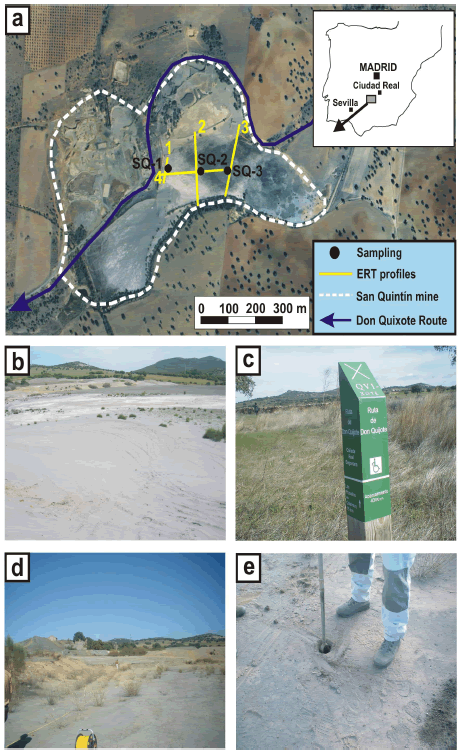
Figure 1. a) Location of the ERI profiles and the sampling sites carried out in the mine pond; b) general view of the mine pond; c) Don Quixote Route milestone at the San Quintín mine; d) location of the ERI 1 profile; e) sampling point SQ-1
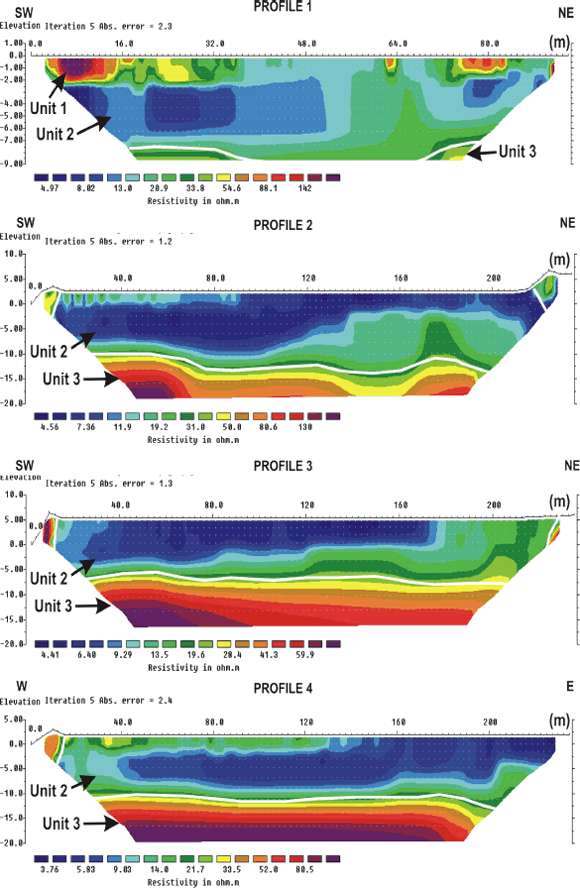
Figure 2. Inverted resistivity profiles obtained from the four ERI sections carried out
ERI profile 1 is 94 m long and runs parallel to the mine pond’s containment dam. Three different units are distinguished: a shallow one with high (80-130 ohm.m) resistivity values, reaching a depth of 2 m and located mainly in the first half of the profile; an intermediate one of low (5-20 ohm.m)
Resistivity values located along the whole profile at a depth ranging from 2 to 7 m; and a lower unit with higher (20-80 ohm.m) resistivity values distributed along all the profile at depths greater than 7 m. Units 1 and 2 correspond to the clayey-sandy materials that constitute the infilling of the mine pond, accounting for a shallower zone with lower water contents (Unit 1) and, a deeper, water-saturated zone (Unit 2). Unit 3, with the highest resistivity values, represents the metamorphic materials that constitute the mine ponds substrate.
ERI profile 2 is 235 m long and runs transverse to the mine pond, starting and finishing in the lateral containment dams. Two moderately high (10 to 45 ohm.m) resistivity areas located at the ends of the profile correspond to the materials constituting the containment dams. Two different units can be distinguished: a shallow one with low (5-20 ohm.m) resistivity values, distributed homogeneously along the whole profile, that corresponds to the materials infilling the pond; and a lower unit, with resistivity values ranging from 20 to 145 ohm.m, associated to the mine ponds substrate. The latter shows some vertical steps and reaches a depth of about 12 m.
ERI profile 3 has the same length and trend that profile 2 but runs along the central part of the mine pond. The observed structure is similar to profile 2: two main units representing the infilling of the pond (5-20 ohm.m) and the metamorphic materials of the substrate (lower unit with resistivity values ranging from 20 to 80 ohm.m). A discrete zone of moderately high (> 60 ohm.m) resistivity values located at the beginning of the profile still corresponds to the materials of the containment dam. The mine ponds substrate is subhorizontal and is located at a maximum depth of about 12 m.
ERI profile 4 is 235 m long and runs transverse to profiles 1, 2 and 3, in order to obtain the geometry of the mine ponds substrate along its longitudinal axis. The obtained results are quite similar to profile 1: a shallow unit reaching a depth of about 2 m, located only in the first half of the profile (15-30 ohm.m); an intermediate unit homogeneously distributed along the whole profile with low (5-15 ohm.m) resistivity values; and a lower, unit, corresponding to the metamorphic material that defines the mine ponds substrate, located at a depth of about 12-13 m (30-100 ohm.m).
In order to obtain more detail of the uppermost structure of the mine pond near ERI profile 1, a GPR survey of 12 profiles was carried out. After calibration using a metallic rebar buried at known depth, a 0.05 m.ns-1 mean EM waves velocity was obtained. Considering that the infilling of the pond is quite homogeneous, this velocity value can be adopted as constant in the entire pond. Taking into account that the window time used is 160 ns, the depth of investigation of about 4 m. This low velocity is related to the low resistivity values of the materials that constitute the infilling of the mine pond. As a result, the investigation depth is small and the attenuation of the EM waves is high. In consequence, this method only provides information about the structure of the first meters depth of the mine pond, proving less useful than the ERI method. Therefore, only one radargram is shown (Fig. 3). Two main units have been distinguished, reaching 0.5-1 m and 2-2.5 m depth respectively, showing a strong attenuation of the EM waves. This is related to a progressive increase in water content from 1 m depth downwards that causes attenuation of the energy of the EM waves. Thus, it could be inferred that the shallow unit is constituted by low water content materials whereas the deeper one is defined by high porosity, water saturated ones.

Figure 3. GPR profile showing the boundary between the two main units identified
A mineralogical composition made up of quartz and illite as main minerals, and Na-Ca feldspar, chlorite-smectite and gypsum as accessory mineral phases, can be defined from the X-ray Diffraction study in all the studied samples (Table 1).
Table 1. Semi-quantitative mineralogical composition (wt%) of the studied samples
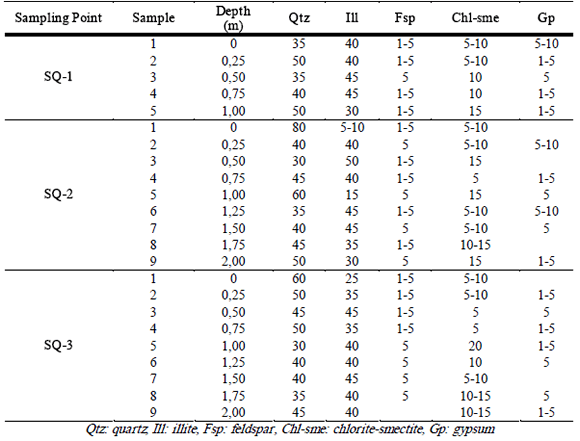
This mineralogical association can be found in the three sampling points carried out. Dolomite has also been identified in trace amounts in SQ-2. From the semi-quantitative analyses, it can be observed that quartz and clay minerals add up to 80-90% of total minerals.
Chlorite-smectites and gypsum have been identified in percentages of 5-15% and 10% respectively. Gypsum is also present in all samples down to 1.5 m in depth, whereas feldspars have been identified only in a minor proportion (5%). An un-expected feature of all the samples is the absence of any sulphide of the mineralogical paragenesis in these mine tailings. Minerals like galena, sphalerite, pyrite or chalcopyrite have not been identified by X-Ray Diffraction
4.3 Geochemistry
Fe2O3total and trace element concentrations at different sampling depths are shown in Table 2. All elements show significant contents and similar percentages in the three sampling points. Elements displaying the highest concentrations are: Cu (up to 1,164 ppm), Fe (up to 7.95 wt%), Pb (up to 24,040 ppm), Sb (up to 1,059 ppm) and Zn (up to 30,344 ppm). These are important amounts in all cases, although predictable due to the type of mineralization that was exploited, which was fundamentally composed of galena (PbS), sphalerite (ZnS), pyrite (FeS2), marcasite (FeS2) and calchopyrite (CuFeS2) [4]. Pb and Zn show specially remarkable contents. Ag, Co and Ni contents do not exceed 350, 643 and 321 ppm respectively, and most of the samples show comparatively low contents of As< 12 ppm and Cd< 10 ppm.
Table 2. Contents in trace elements of the samples from the San Quintín tailing pond (values in ppm except for Fe2O3total "in wt%")
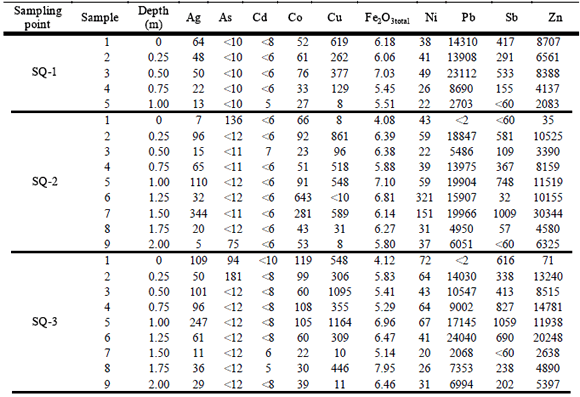
All analyzed elements show significant variations in their contents as a function of depth. Such a variation defines a pattern with two depth levels showing different metal contents: the highest ones occur between 0.25 and 1.5 m (samples 2 to 7), whereas the lowest ones are located between 1.75 and 2.0 m (samples 8 and 9) (Fig. 4). Within the first depth interval, preferential concentration of Pb and Zn at 1.25 m depth is defined in SQ-3, whereas the same occurs in SQ-2 at 1.50 m depth (Table 2; Fig. 4).
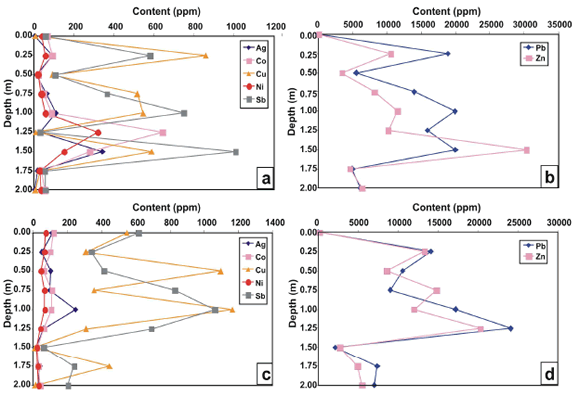
Figure 4. Distribution-with-depth profiles for: a) Ag, Co, Cu, Ni and Sb from SQ-2 sampling point; b) Pb and Zn from SQ-2 sampling point; c) Ag, Co, Cu, Ni and Sb from SQ-3 sampling point; d) Pb and Zn from SQ-3 sampling point
5. DISCUSSION AND CONCLUSIONS
An integrated geophysical, geochemical and mineralogical study has allowed us to obtain information about the geometry of the mine ponds substrate, the thickness of the infilling, its water content and its mineralogical composition.
All this information has revealed the internal structure of the mine pond and its physico-chemical properties, which constitutes a valuable tool in order to evaluate its potential as a pollution source and to design the reclamation measures to be adopted in the future.
The geophysical survey has provided the geometry of the mine ponds substrate that reaches a maximum depth of about 12 m. In addition to this, two different units have been defined for the infilling of the pond: a shallow one, laterally discontinuous, corresponding to materials with low pore water content, and a deeper unit, thicker than the first one and always present in all the studied profiles, which is interpreted as water saturated materials defining the infilling of the mine pond. As these materials produce a strong attenuation of the GPR signal, the ERI technique reveals itself as the most useful method to unravel the internal structure of this kind of mine deposits.
The mineralogical composition obtained in this work is similar to the one described in a previous one [11]. In both works, no metallic minerals, either from the ore body or from subsequently treated dumps, were identified by X-Ray Diffraction, due to the rework of the tailings made by the company who owned the mine (SMMP) that drastically reduced the presence of this kind of minerals in the mine ponds and the occurrence of sulphates as a weathering product of the sulphides. It has to be taken into account that X-Ray Diffraction is only able to detect the occurrence of mineral phases present in quantities greater than 5 wt%. Thus, this would be the upper limit of concentration for each mineral phase for the analyzed samples, representing an important amount of metallic elements constituting a potential hazard. High contents in potentially toxic elements, such as As, Cd, Cu, Pb, Sb and Zn, are clearly greater than the maximum allowed values for agricultural soils defined in the European Community Directive [12]. Some examples of concentration values greater than the allowed ones are: 300 ppm for Pb and Zn, 140 ppm for Cu and 3 ppm for Cd. This fact is frequent in all the mine ponds derived from sulphide extractions, constituting deposits with a high degree of pollution, especially if accompanied by acid mine drainage that can affect nearby water courses. Nevertheless, the mine pond infilling presents pH values ranging from 6.2 to 8.1, which seems to indicate that no acid mine drainage is being generated in the San Quintíns mine pond.
Different infilling levels of the mine pond exhibit different concentrations of metallic elements. This can be explained by the development of more efficient extraction techniques, together with the treatment of ores bodies with different concentrations and, mainly, the rework of the tailings deposits. Figure 4 clearly shows that levels with the highest metallic elements concentrations are located at 1.25-1.5 m depth, with a difference in topography between SQ-2 and SQ-3 of 0.25 m, probably due to the different distance of these points to the original point of discharge.
Last but not least, it can be highlighted that this abandoned mine group is visited by a large number of tourists as it constitutes part of the Don Quixote Route [13]. Although these kinds of tourist initiatives are noteworthy in terms of geological heritage, it is surprising that a previous characterization and reclamation work has not been afforded previously to the implementation of this new use.
REFERENCES
[1] HERNÁN, L., GONZÁLEZ, L.M., ESPINOSA, A. Modelación de elementos traza en el horizonte A de suelos, plancha 170 (Vélez, departamentos de Santander y Boyacá). DYNA, 156, 157-164, 2008. [ Links ]
[2] PALERO, F.J., BOTH, R.A., MANGAS, J., MARTÍN-IZARD, A., REGUILÓN, R. Metalogénesis de los yacimientos de Pb-Zn de la región del Valle de Alcudia (Sierra Morena Oriental). In: Recursos Minerales de España (Eds. García Guinea, J. and Martínez Frías, J). CSIC. Madrid, 1027-1067, 1992. [ Links ]
[3] PALERO, F.J. Evolución geotectónica y yacimientos minerales de la región del Valle de Alcudia (sector meridional de la Zona Centro Ibérica). [PhD Thesis] . University of Salamanca, 1991. [ Links ]
[4] TELFORD, W.M., GELDART, L.P., SHERIFF, R.E. Applied Geophysics. Cambridge University Press, 770 p., 1990. [ Links ]
[5] REYNOLDS, J.M. An Introduction to Applied and Environmental Geophyscis. Wiley, Chichester, 796 p., 1997. [ Links ]
[6] MARTÍN-CRESPO, T., DE IGNACIO, C., GÓMEZ-ORTIZ, D., MARTÍN-VELÁZQUEZ, S., LILLO-RAMOS, F.J. in press. Monitoring study of the mine pond reclamation of Mina Concepción, Iberian Pyrite Belt ( Spain ). Environmental Earth Sciences, 59, 1275-1284, 2010. [ Links ]
[7] GÓMEZ-ORTIZ, D., MARTÍN-VELÁZQUEZ, S., MARTÍN-CRESPO, T., DE IGNACIO-SANJOSÉ, C., LILLO-RAMOS, F.J. in press. Application of Electrical Resistivity Tomography (ERT) to the environmental characterization of abandoned massive sulphide mine ponds (Iberia Pyrite belt, SW Spain). Near Surface Geophysics, 8, 65-74, 2010. [ Links ]
[8] MARTÍNEZ-PAGÁN, P., FAZ-CANO, A., ARACIL, E., AROCENA, J.M. Electrical resistivity tomography revealed the spatial chemical properties of mine tailings ponds in the Sierra Minera ( SE Spain). Journal of Environmental & Engineering Geophysics, 14, 63-76, 2009. [ Links ]
[9] SASAKI, Y. Resolution of resistivity tomography inferred from numerical simulation. Geophysical Prospecting, 40, 453-464, 1992. [ Links ]
[10] DAVIS, J.L., ANNAN, A.P. Ground-penetrating radar for high-resolution mapping of soil and rock stratigraphy. Geophysical Prospecting, 37, 531-551, 1989. [ Links ]
[11] RODRÍGUEZ, L., RUIZ, E., ALONSO, J., RINCÓN, J. Heavy metal distribution and chemical speciation in tailings and soils around a Pb-Zn mine in Spain . Journal of Environmental Management, 90, 1106-1116, 2009. [ Links ]
[12] COUNCIL OF THE EUROPEAN COMMUNITIES. Off. J. Eur. Communities L181, 6–12, 1986. [ Links ]
[13] MARTÍN CRESPO, T., GÓMEZ ORTIZ, D., MARTÍN VELÁZQUEZ, S. Valor ecoturístico de la mina de San Quintín, Ruta de Don Quijote, Castilla-La Mancha. In: Congreso Nacional de Medio Ambiente 9, Workgroup Rehabilitación de Espacios Mineros, 2008. [ Links ]














